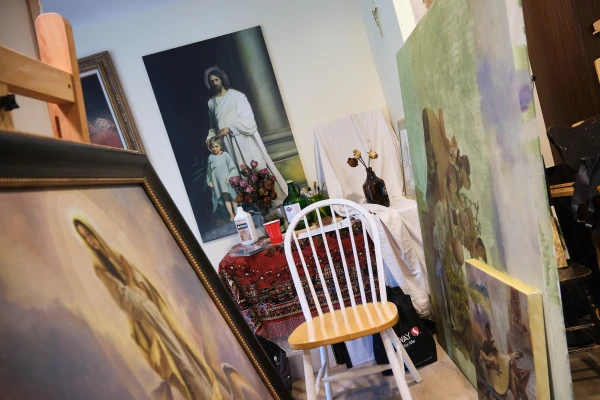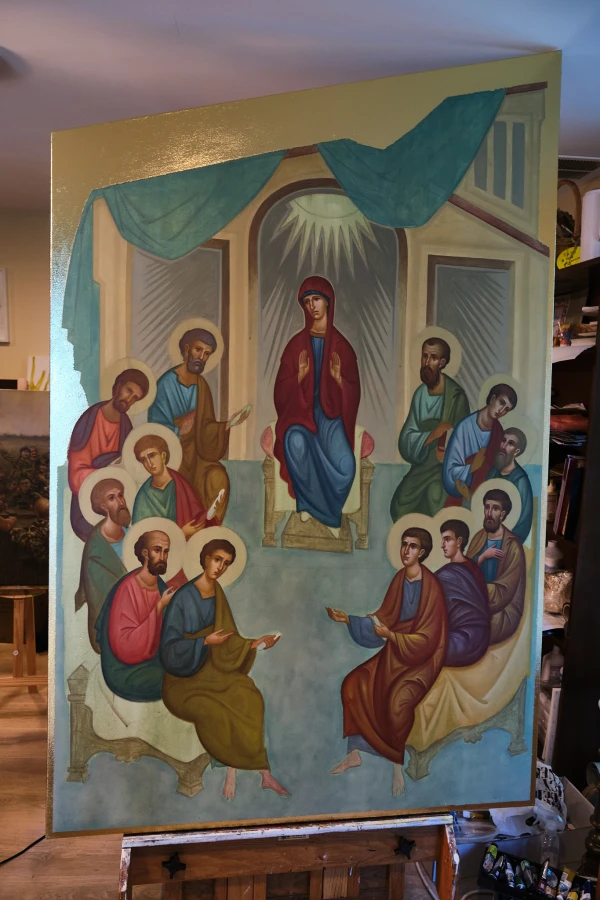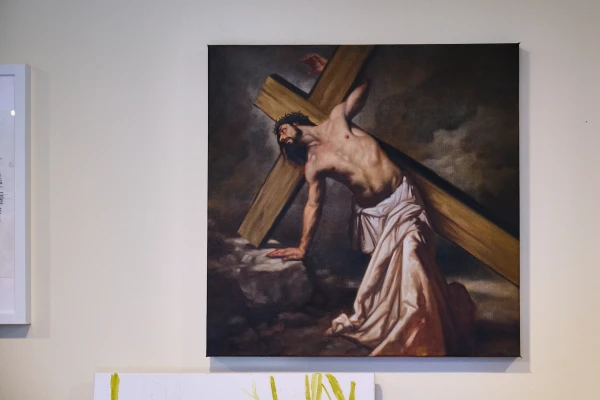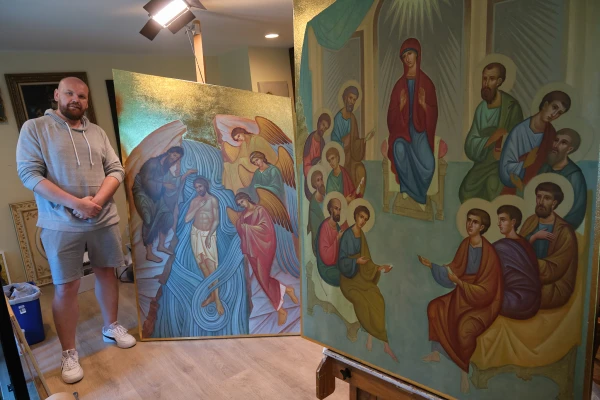Vancouver, Canada, Jul 22, 2023 / 04:00 am
Iconographer and refugee Serhii Kolodka’s studio at Holy Eucharist Ukrainian Catholic Cathedral in New Westminster, British Columbia, Canada, is standing room only. Paintings line the walls and lean against easels on the floor. Pastoral folk art hangs next to historical reproductions and religious paintings. Kolodka is not a traditional iconographer by training, and his use of oil paints — as opposed to egg tempura or other traditional mediums — is evident in the intricate images crowding the room.
When the war with Russia broke out, Kolodka was only allowed to leave Ukraine because of his three children. Holy Eucharist played a large role in helping him settle, and he has been working as a live-in artist for the cathedral for the last year.

The New Westminster cathedral has supported more than 1,000 refugees since the war started, helping them make housing arrangements, find jobs, and receive English lessons.
The cathedral’s pastor, Father Mykhailo Ozorovych, told The B.C. Catholic that the church took a financial risk in hiring Kolodka as its full-time artist, and while the first year didn’t see a great return on investment, things are starting to look up.
Last year saw the occasional contract for a portrait trickle in, but today Kolodka is putting the finishing touches on his first major iconographic project for a local parish, a pair of matching panels depicting Pentecost and Christ’s baptism in the Jordan for Holy Spirit Church in New Westminster. The panels were scheduled to be installed on July 9.
Ozorovych said this project has historical resonance because the local Ukrainian Catholic community originally celebrated Divine Liturgy at Holy Spirit Parish before the construction of Holy Eucharist.
The icons are meant to accentuate the Holy Spirit’s patronage by depicting two of the most significant New Testament instances of the Holy Spirit working in the world.
The icons are written in the Byzantine iconographic style, where care and attention are given to the faithful reproduction of existing iconographic motifs as they are represented in the iconographic canon.
Working in this more restrictive, traditional style is uncommon for Kolodka.
“There is lack of freedom in the Byzantine because the canon has been developed over so many centuries,” Ozorovych translated.

But while he describes working in a non-Byzantine style as “more free,” Kolodka believes both have value and equates each style of visual art with a different kind of prayer.
Referring to the non-Byzantine images around his studio, he said: “Realism is more like my personal conversation with God, and Byzantine iconography is more like the Our Father. Of course, personal prayer should be there, but [the Our Father] is a stable, unchanging prayer, that if you do it will give you a personal connection with God.”
Byzantine iconography, with its rigid structure, “is that stable, unchanging prayer,” he said.
Kolodka is also going to create a faithful reproduction of the divine mercy image that hangs in Holy Rosary Cathedral and in many local parishes.
(Story continues below)

“One of the places we want to offer something unique is at the Holy Rosary Cathedral,” Ozorovych said. “They have an amazing icon of Our Lady of Guadalupe to the right of the altar that is a high-quality piece of art. It has power to it.”
The current divine mercy image will be replaced with a faithful reproduction of the divine mercy image that is in the Divine Mercy Sanctuary in Krakow, Poland, with four additional paintings paying homage to the four apparitions depicted in Nicolás Enríquez’s 1773 painting of the Virgin of Guadalupe.
In addition to the religious paintings, Kolodka is working on political paintings reflecting the war raging in Ukraine.
He is especially interested in talking about his allegorical painting depicting Ukrainian military and journalists currently working in Ukraine as they write a fictional letter to Vladimir Putin.

The image pays homage to Ilya Repin’s late 19th-century oil painting “Reply of the Zaporozhian Cossacks,” which depicts an event from 1676 in which the Zaporozhian Cossacks (from southeast modern-day Ukraine) penned an insulting letter to the Ottoman Sultan in response to his demand that they surrender after they defeated the Ottoman army in battle. The painting is a symbol of national identity for Ukrainians.
Kolodka’s painting is not just a political statement but is meant to contribute to the history of the Ukrainian war as a document of the emotions and grit of the Ukrainian people.
Kolodka was also involved in an exhibit featuring artwork by Ukrainian art students to raise funds for Ukrainian support.
This article originally appeared in The B.C. Catholic and is reprinted here with permission.





